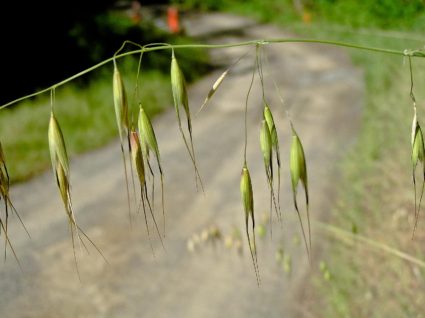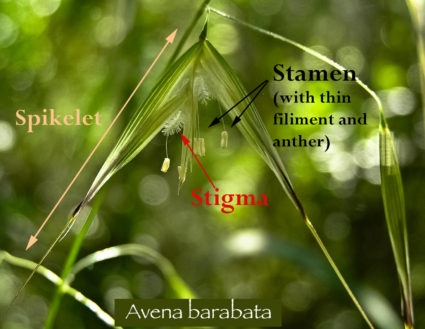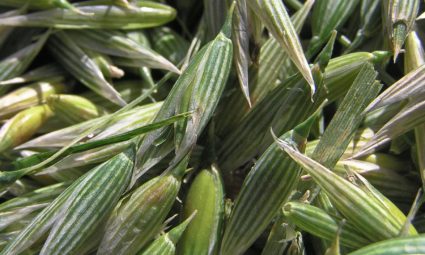
This is a monograph about oats, the same plant that oatmeal comes from, but here the focus will be on how it is used medicinally.
One thing that can be said about this plant is that unless you have a specific oat allergy, it is a very safe, nutritive plant. As such, a wide variety of people, including those that are often sensitive to other medicines, can use it. It is one of those plants that straddles the line of ‘is it a food, or is it a medicine’, which is often an arbitrary line anyway.
Avena Botany and Nomenclature
There are a couple of common names for Avena depending on which of the different parts of the plant is being used. The mature seeds are the part used for food and depending on how they are processed are called oats, oatmeal, rolled oats, etc. In herbal medicine the immature flower heads and the stems and leaves are the main parts used. Generally when the immature flower heads are made into a tincture (see Medicine Preparation below) it is called fresh milky oat tops, or milky oats. This is because there is a white fluid that is exuded from the flower head at this phase of its development, and it is the preferred time to tincture the plant.
The other parts of the oat plant employed for medicine are the dried stems (technically called a culm) and leaves. Sometimes the immature seed heads are sold along with the culm and leaves. These are most often used for tea and are called oatstraw or wild oats.
One of the things that always seemed ironic to me is seeing the dried plant straw sold in jars in markets for medicine, and then driving along and passing by large bales of hay sold for much less. The baled oatstraw is generally sold for animal bedding.
Botany
Avena is in the Poaceae (also called the Gramineae), the grass family, which is one of the largest families of plants and with one of the widest distributions. This family contributes a significant portion of the human diet and includes rice (Oryza), wheat  (Triticum), corn (Zea), sugar cane (Saccharum), rye (Secale), along with others. The grasses have their own distinct botanical characteristics. It is too technical a family to cover here but there is a photo of Avena barbata which shows a spikelet (the inflorescence) from the plant containing 2 florets (small flowers). The dangling parts (yellow on a thin string) are the stamen. Each floret has 3 stamens. And the feathery part is the stigma, where the pollen will be caught. The whole spikelet is the part that will eventually mature into the milky oat top.
(Triticum), corn (Zea), sugar cane (Saccharum), rye (Secale), along with others. The grasses have their own distinct botanical characteristics. It is too technical a family to cover here but there is a photo of Avena barbata which shows a spikelet (the inflorescence) from the plant containing 2 florets (small flowers). The dangling parts (yellow on a thin string) are the stamen. Each floret has 3 stamens. And the feathery part is the stigma, where the pollen will be caught. The whole spikelet is the part that will eventually mature into the milky oat top.
The most commonly used species is Avena sativa (and it cultivars). This is the species that is cultivated for its consumption and if you see large fields of oats, it will be this species.
There are two weedy species that are probably useful as well. They look very similar to Avena sativa, and one would need to botanize them to see the differences. I don’t know if anyone purposefully gathers them, but they taste similar and probably are just as useful. The first is Avena fatua, which is a common weedy oats (meaning not purposefully planted) and is commonly found wherever people grow A. sativa. The second is another weedy species, Avena barbata, which is found mostly in California. These can be found growing along roadsides and other non-garden places, but so can Avena sativa.

Wildcrafting and Gathering
The most likely place one will gather Avena sativa is from farms. It has a distinctive green color and once learned can be easily spotted while driving along. You can then ask the folks growing it if they wouldn’t mind you gathering some of the tops. This will likely bring incredulous looks (which the herbalist should be familiar with by now). It shouldn’t impact their crop, and you likely to get permission. You may want to find out if the crop is sprayed. The second place is along roadsides where you may find any of the three above-mentioned species.
I also ask my organic gardening friends if they will grow a row of it for me, as it is pretty easy to grow. I trade herbal medicine and consultations with local farmers for these favors.
Few tools are needed for gathering this plant. First I make sure it is the right time to be gathering the plant. It is easy to test, just squeeze the immature oat top and a medium-thin white fluid will emerge from the base. Those of you who enjoy pimple popping will like this aspect. Not all of them will exude this fluid, but a majority should. Now it is time to gather. I usually just bring a brown paper grocery bag and turn down the sides so that it stands upright. I then walk along the rows, using both hands in a loose fist and drag my hand upward along the stem gathering the oat tops. It takes a bit of practice and initially you will be pulling some of the oat plants out of the ground. It takes a while to fill a bag, but that is a good amount of medicine depending on what you are going to do with it. You may also want to bring pruners and cut a number of the stalks and dry them for tea.
Processing, Medicine making and Preparations
There are two common ways of processing the Avena, one is drying it for tea, and the other is tincturing the fresh oat tops.
First, directions for preparing the tincture. Freshness is important in preparing fresh milky immature seed tops tincture. The day that I gather them I set aside as the day I will also process them. After trying a number of different methods I feel the best way to get the medicine from them is by using a blender. There are a number of reasons for this, and one is that the oat tops are light and bulky and take up a lot of room in the jar you will tincture them in. So that if you try to cover them with alcohol, it is weak, even if you jam them tight in the jar. Blending them breaks down the plant material much further and makes for a stronger medicine. I use a Vita-mix blender for preparing tinctures, they are a bit pricey, but I think worth it. (If you decide to purchase one, I would suggest a used one and the kind that has a reverse motion to its motor, which is very useful for tincturing). I blend the tincture at 1:2 80% ethanol, and it turns a psychedelic lime green color.
If you do not have a blender, try to double macerate it fresh. It would be very helpful to have a tincture press for this method. If you grow them yourself this wouldn’t be too hard. Gather the amount you want to tincture at the earliest date of the oats going milky. Press them firmly into a jar and cover with 80% ethanol. The oats should stay milky for a week or so. Before they become dry (that is, when you press on the oat heads, nothing comes out) press the tincture you have already made. Gather more fresh milky oats and add the previous tincture onto them. That should make it substantially stronger.
The second oat medicine is by drying the culm, leaves and any leftover tops. Warning, the culms (the fatter part of the stem bearing the leaves and flower top) mold easily even after they seem dry. I have had this happen a few times. I dry the aforementioned parts (usually in a dehydrator) and then put them in a jar to keep. Some time later I will open the jar to find the culm (not the leaves nor tops) moldy. I assume there are some persistent fungi within the culm, and in the right conditions (such as a jar with a lid) it does its moldy thing. I suggest storing them in a paper bag, as they less often become moldy. But still, make sure to dry them thoroughly.
A Processing Story
Some years back, I was on a class field trip to the Adirondacks, visiting my friend Paul Murtha who owned a beautiful piece of land he called Myrthwood. While we were in the Adirondacks we also visited Jean Argus of Jean’s Green’s who let us pick a whole bunch of the Avena she had sowed. So we gathered the milky tops and brought them back to Paul’s and I asked to use his blender to process them.
Before I go further in this story, it is important to know that Paul had just finished building his kitchen and painted part of it white (a bit of foreshadowing here).
I was blending the oat tops and adding alcohol and….shwoosh, the top flew off and the blended Avena flew out. The tincture splattered the walls, leaving them that lime green color I mention previously. It stained all too well and Paul had to re-sand and re-paint the areas where the accident occurred. If you are reading this Paul, once again I apologize and thank you for letting me take so many of my students to your lovely place. Paul now lives in Ecuador, hopefully not due to all the classes I brought to Myrthwood.
Medicinal Attributes
The main medicinal attribute of Avena is as a nerve tonic. A tonic meaning it is more useful taken regularly for its nerve calming

properties rather than an on-the-spot first aid plant (such as Scutellaria). It does not have dramatic action, it slowly and consistently helps restore ones ‘nerves’. But what does ‘nerves’ mean? Here I am referring to a feeling acquired from those that have pushed and pushed and now feel tired, out-of-sorts, or just plain disconnected much of the time no matter how much they rest or sleep.
I think of Avena primarily as a vata remedy, and would like to characterize some vata traits. While it is a fun exercise to generalize these characteristics, it is important to remember they are just caricatures. Individuals who may have some of these characteristics, may also have other parts of themselves that don’t fit the vata mold at all. One’s traits are most pronounced when that part of them is out of balance. An example, I’ve talked elsewhere about how pitta-types may react if they get a flat tire while running late for an important event. Their tendency is to start bossing everyone around and laying blame. In the same circumstance, a vata-type may lose their ability to concentrate and start to panic, and run in circles; “what are we going to do, what are we going to do?” But what is important to understand is that anyone could also just rationally and realistically work their way through the situation. It is the dosha imbalanced (at least temporarily) that we see these actions. While it is important to take the individual into account during treatment, there are times when these archetypical characteristics are helpful in making herbal and lifestyle recommendations.
Here are some more concepts of vata, and hence characteristics of people who might benefit from oats. Their thoughts easily becoming scattered and have a hard time staying focused, especially with a lot of distractions around (think sports bar). This type of person lives for spontaneity and creativity which is often at its peak in the wee hours, when the rest of world is quieter. It may be difficult to gain weight and there is a constant need to snack. If there is nothing to eat, disorientation sets in. They can be very empathic and may find themselves crying during television commercials. These are just a few traits and hopefully give a glimpse into the vata archetype.
While oats are a fine vata tonic, anyone feeling frayed can enjoy a cup (or quart) of this tea. One of the reason it is more specific for the vata constitution is the same reason it is so widely eaten as food, and that is that it is nourishing. And if there is one fundamental treatment for vata types, it is feeding deficiencies. Building up.
The tea is a better building tonic than the tincture, and the fresh milky oat top tincture is stronger than the tea. For those who feel exhausted or easily scattered it may be helpful to drink the tea throughout the day, and use the tincture when needed.
Some other nervine qualities of Avena are for anyone who feels they have plundered their nervous system reserves and now have a hard time focusing and have become rather snappy. It may also help folks who have difficulty falling asleep who when they lay down, their mind becomes a cacophonous enclave of disconnected swirling thoughts. This is different than a more pitta-type of insomnia where the person goes through a litany of all the things they should have done that day, or could have done better. (Or, for the true pitta ‘check’, telling people off in your mind).
Dosage
Avena preparations are some of the safest nervine remedies. While they don’t have the punch of some, they rarely leave one feeling addled or tired. The amount used is really just an individual decision. The main suggestion is to use it on a regular basis. And schedules can help bring order to a scattered mind, so consider using them at a regular time throughout the day.
The tincture is also useful to take throughout the day, ½-2 dropperfuls (.60-2.5ml) as often as needed, taking larger amounts when troubling circumstances lie ahead (or behind).
Summary
I hope this monograph gives insight into using this safe, easily prepared, non-endangered plant. Just drink a few cups and see if you like it’s oaty flavor, and perhaps you will find it a helpful nerve restorative.

Thanks 7Song, this was great! 🙂
Thanks! I loved this.
Loved it! Had to giggle at some of the dosha references and this: “This will likely bring incredulous looks (which the herbalist should be familiar with by now)”….so funny, so true!
Thanks 7Song, enjoyed the read. I plan on planting oats this season, the harvesting tips are a great help.
I really like hearing your voice in this. Thank you.
cacophonous enclave of disconnected swirling thoughts:)
GReat Monograph on Avena! Thank u 7song
Most helpful! Thanks for the good information.
Thanks 7Song! I enjoyed reading this before tincturing my first batch of fresh milky oats. Your writing and generosity to share knowledge is greatly appreciated here!
Thanks for letting me know Kelly, I am glad it was helpful.
Thank you very much Kelly, I appreciate the feedback.
~7Song